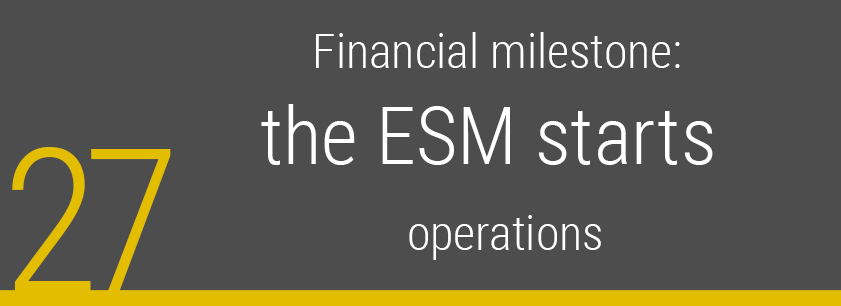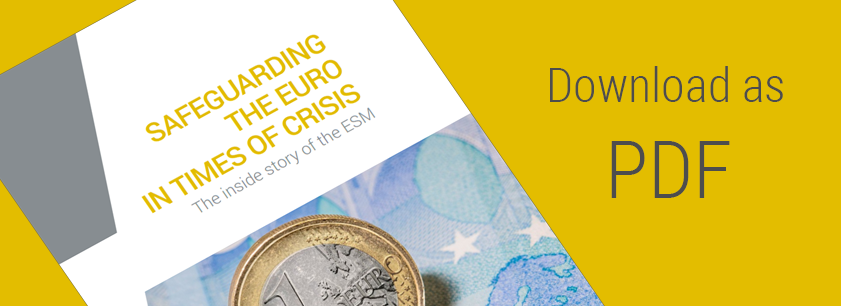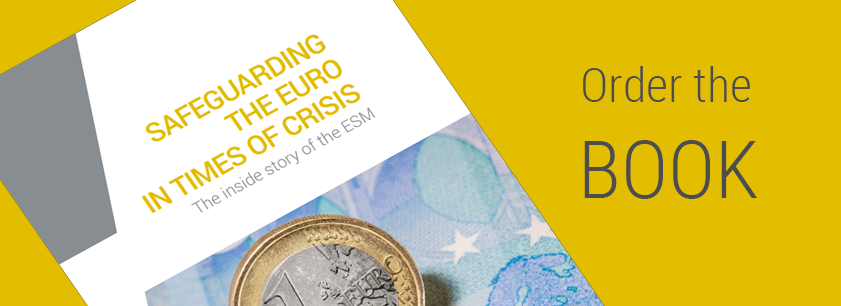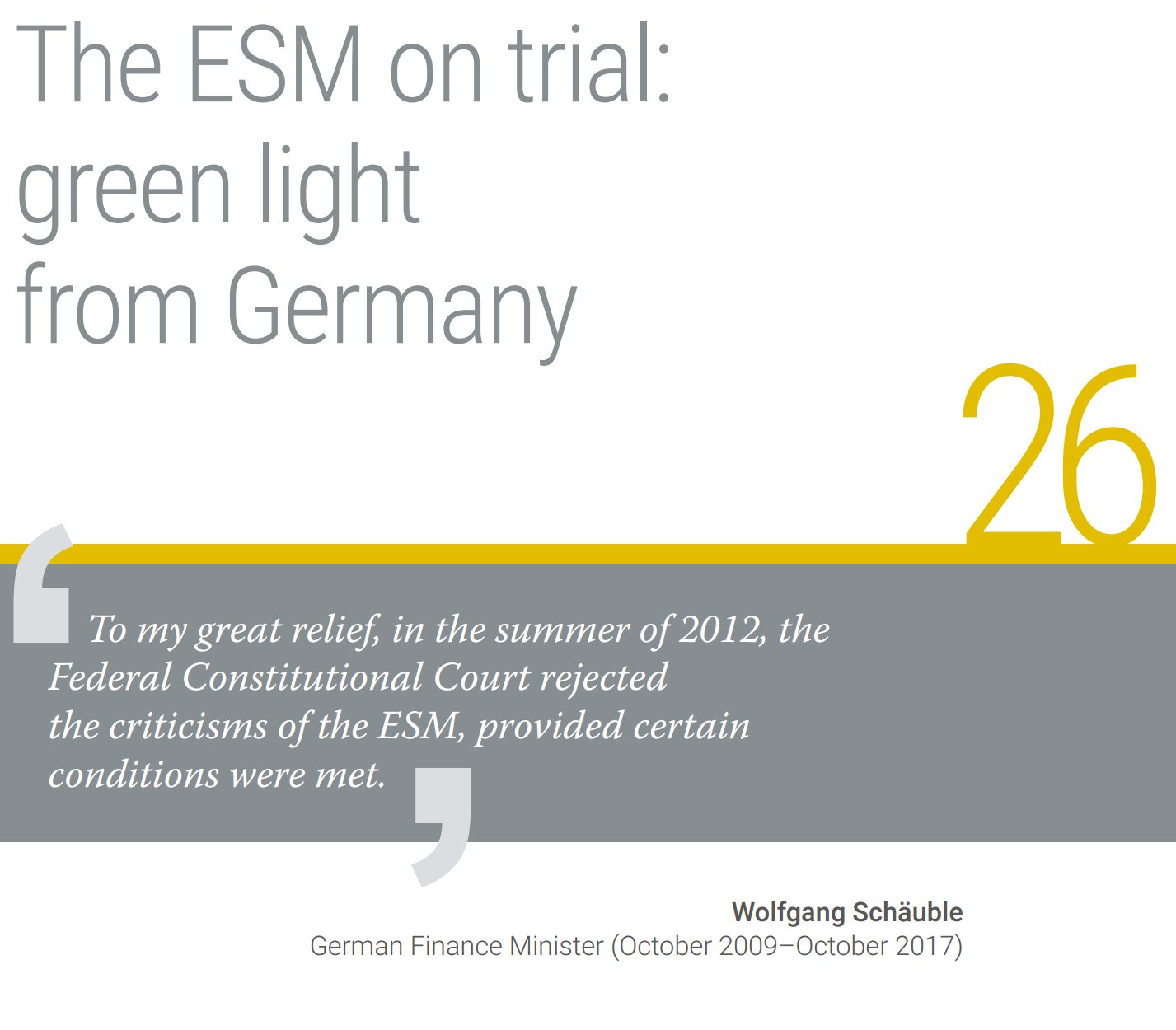
On 10 July 2012, a panel of judges in the distinctive red robes of Germany’s Federal Constitutional Court filed into a hearing that would ultimately decide whether or not the ESM could proceed. Resentment against Europe’s new firewall was bubbling into legal challenges across the euro area, with cases pending in Estonia and at the Court of Justice of the European Union. But, given the timing – Spain and Cyprus had requested programmes only 15 days earlier – and the size of Germany’s would-be contribution to the rescue fund, the Karlsruhe-based judges were seen as holding the future of the euro in their hands.
If the court ruled that ratifying the Treaty establishing the ESM[1] would violate Germany’s constitution, the new firewall would be unable to go forward. If the court gave the ESM its blessing, the euro area would have a firm foundation for its new permanent backstop. The high court had already ruled on the EFSF. In reviewing the ESM, its decision had even bigger stakes.
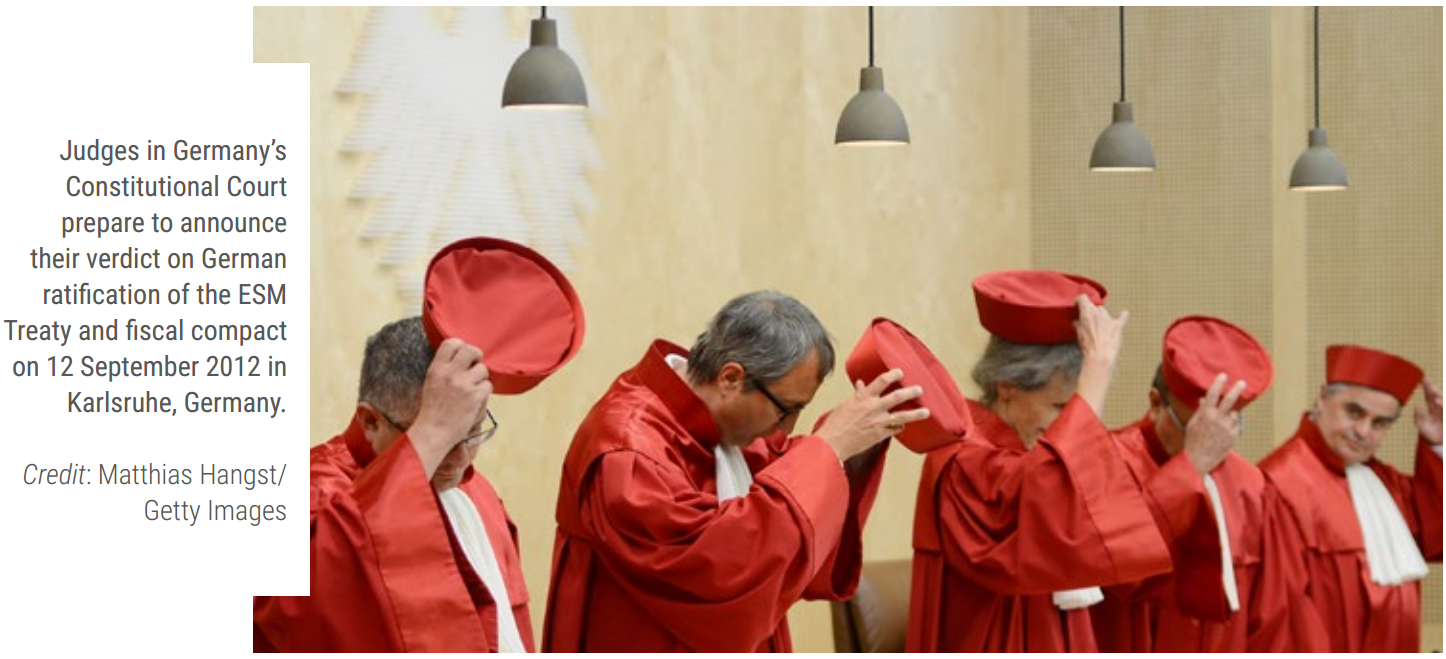
Chancellor Merkel’s government was extremely sensitive to public opposition. Some 37,000 German citizens had signed a petition questioning the proposed ESM, including the Bavarian politician Peter Gauweiler of the Christian Social Union party, who had also led an earlier legal challenge[2]. Yet more tellingly, 54% of Germans polled hoped the Constitutional Court would block the ESM, according to a YouGov survey commissioned by the German news agency dpa and conducted between 3 and 5 September 2012[3].
At the time, ratification of the ESM Treaty was proceeding apace across the euro area. On the date of the German Constitutional Court hearing, 10 July, nine countries had ratified it and that number would reach 14 by the end of August[4]. The German parliament had approved it on 29 June, but it could not become law until it was signed by Germany’s president, a move that would not happen without the court’s endorsement.
Jansen, the ESM’s first general counsel, described the mood at the July hearing as ‘very, very tense’ – one German official working on the project told Jansen that his children had received death threats. ‘It was a very bad situation,’ he said. ‘It was emotional. Some people were outraged.’
Like Managing Director Regling, Chief Economist Strauch and others in the ESM’s senior leadership, Jansen was German and understood the quandary facing the country’s leaders. ‘The government knew it needed to be done,’ Jansen said. But there was also ambivalence: ‘They knew it was so unpopular that they could not praise it too much, because then they would not be re-elected, but they also could not risk letting the project fail because that would have been the end of Europe.’
Opponents of the firewall believed it would saddle Germany with the bill for profligacy elsewhere – and were determined to stop it. In the earlier case before the Karlsruhe-based top court, Gauweiler and a group of professors had filed a suit against the German government’s support for Greece and the EFSF. On 7 September 2011, the court had ruled in favour of the euro area’s firewall strategy, but it made clear that German lawmakers had to be consulted on all key steps[5].
Then-German Finance Minister Schäuble said those initial Karlsruhe decisions were essential for gaining public acceptance. ‘The basic approach behind the Federal Constitutional Court’s rulings was to ensure that taking on overly high risks did not undermine the fundamental principle that the Federal Republic of Germany is a parliamentary democracy based on the rule of law, and that future parliaments should remain free to make their own decisions,’ Schäuble said. ‘In the worst-case scenario, Germany would have been liable for significantly more than the agreed share of 27%.’
Looking back, Regling views Germany as home to some of his most important and most difficult audiences. In numerous public and private appearances, Regling sought to explain that the rescue fund’s programme financing comes from the market, not from the German budget, nor from the taxes that German workers have paid. While the German budget would bear some additional risk, it would not take on any new costs. ‘I think I was helpful in calming down the hostility somewhat, but it was sometimes very severe,’ he said.
In early 2011, for example, he spoke at a meeting of Germany’s federation of family-run businesses alongside his one-time boss, former Finance Minister Theo Waigel. From their perch on the podium, even before they began to speak, they started to wonder about the hundreds of family entrepreneurs in attendance.
‘It was so hostile,’ Regling recalled. ‘The way we were introduced was so aggressive, we were thinking: “Where’s the emergency exit? Are we getting out of here unharmed?” It was really bad. It was one of the worst experiences I’ve ever had.’
Other ESM/EFSF team members also attempted to rally support at home. Secretary General Anev Janse appeared on Dutch television, and spoke to the European Parliament’s budget audit committee and to Dutch members of parliament to make the case for a joint rescue facility for the euro area. As he remembers it, the idea was received with hostility amid a public perception that Greece had brought its crisis upon itself through its own policy mistakes.
Back in Luxembourg, the EFSF was doing its best to proceed calmly, as if there were not a momentous legal challenge pending. Regling, who had to keep international investors convinced that the euro area’s rescue funds were a good place to invest their money, avoided comment on the case.
The rescue fund continued to manage its programmes for Ireland, Greece, and Portugal, and to monitor the progress of Spain’s and Cyprus’s requests for assistance. Hiring continued and the core managers kept up their institution-building efforts. At the time, the EFSF was aiming to expand its workforce, to around 75 from 47 employees by the end of 2012. People were very interested in how the firewall was developing, to the extent that Germany's Spiegel Online included a mention of the firewall’s new logo in a September 2012 profile of ESM preparations[6].
‘It was quite a risk,’ said Giammarioli, the ESM’s head of strategy and institutional relations. ‘I had to create my own division, to establish myself, to recruit, and to take strategic decisions for the institution as a whole. All the while, I was aware the ESM might not happen because there was this pending constitutional decision in Germany.’
Given the stakes, the ESM team couldn’t afford the slightest misunderstanding. German judges running the proceedings were experts in national law, not euro area policymaking, and were therefore not necessarily familiar with the firewall framework, Jansen recalled. Throughout the process, he and his colleagues were on hand to explain or clarify how the ESM would work, the role of national parliaments in its procedures, and other technical details.
‘The court is very serious and sober,’ Jansen said. ‘But seeing the symbols of the German state, the eagle, the flag and the European flags – you know history’s being written here.’
The July 2012 hearings took place in a temporary building, while the court’s main chambers were under renovation. In addition to a huge turnout of European media, US and Asian journalists joined the pre-hearing media crush in front of the court. Once proceedings began, the camera crews were sent out and official recordings took over.
Hearings in Karlsruhe normally last a few hours, but for this case the testimony stretched well beyond that, with only short breaks for the participants. Finance Minister Schäuble and other senior officials were present, underscoring the importance of the hearing for Germany as well as for the ESM.
‘Because it was a long day, we went to lunch at the nearby canteen. Everybody was queuing like at school, getting their food, and that included all the “important” people,’ Jansen said. While those officials who were grasping trays awaited the decision in Germany, another legal logjam was facing Regling’s team 2,000 kilometres away.
Two days after the German hearing, Estonia’s Supreme Court ruled on a similar case, assessing the treaty’s constitutionality before its ratification by Estonia. The challenge contended that the treaty impeded Estonia’s right to decide on its use of public funds – the paid-in and callable capital Estonia would contribute represented approximately 8.5% of the country’s GDP. On 12 July 2012, the court said that the ESM should proceed because Estonia faced a greater threat from currency destabilisation than it did from any potential restriction on parliament’s powers over the use of national resources[7].
Often the German Constitutional Court can take years to issue full rulings. When it came to the ESM challenge, such was the urgency that the court agreed to make a temporary ruling within two months. On 12 September, the day of the decision, the ESM/EFSF team trooped down to Karlsruhe. Jansen said the suspense lasted until the moment of the announcement, with concerned institutions preparing press releases for both outcomes and holding their breath to see how it would go. The decision was due at 10.00.
‘Then everything happened really quickly,’ Jansen said. ‘The court basically said we can go ahead with it, but they had certain conditions.’ It was essential, the court ruled, that any further German contributions to the ESM be subject to German parliamentary approval, and that the rest of the euro area acknowledge these German constraints[8]. The Eurogroup’s press release welcoming the decision went out within minutes, and the final steps in the German ratification process were set in motion.
For both the ESM and the EFSF, the German court proceedings were ultimately constructive, Regling said. Even though a part of German public opinion remains eurosceptic, the court’s deliberation shows that the firewalls are compatible with German law. ‘That, in the end, was very positive because they said clearly that setting up the EFSF and the ESM was in line with the German constitution,’ Regling said.
Germany submitted its ratification papers on 27 September. This meant the treaty could enter into force and the ESM could be established, because the treaty stipulated that member states representing 90% of the ESM’s capital contributions must ratify it before it could take effect. Germany’s ratification pushed it over that threshold. The formal announcement that the ESM Treaty had entered into force came in a three-sentence ‘note verbale’ from the Council of the European Union in Brussels, the ESM Treaty’s depositary. Estonia then became the final euro area member state to ratify the treaty, just under a week later on 3 October.
The ESM existed on paper, but it wouldn’t become operational until euro area finance ministers, meeting as the firewall’s Board of Governors, approved everything from the rules of procedure to tax regulations for the salaried staff. There were only a few days to complete the internal preparations that had begun in September 2011 with what Anev Janse recalls as ‘blue sky thinking’ about the inner workings of the permanent fund.
Documents for the founding of the new fund were doublechecked and proofread on laptops supplied by the EIB, which had offered the EFSF start-up assistance. ‘These were EIB laptops with EIB stickers on them and our binders even for the ministers’ meetings were EIB binders, and you sometimes still see them at the ESM,’ Anev Janse said.
In parallel, there was still some unfinished legal business. The Court of Justice of the European Union had been asked to weigh in after an April 2012 challenge by the Irish lawmaker Thomas Pringle, who argued that the establishment of a permanent firewall required a more extensive amendment to EU treaties than the simplified procedure that was used, including referendums if necessary under national law.
The case had been dismissed by the Irish High Court and then referred up to the Court of Justice[9]. In an extraordinary move, indicative of its novelty and precedent-setting potential, the full 27-member EU court heard oral arguments on 23 October 2012. It returned its ruling under an accelerated procedure on 27 November. It concluded that the EU Treaty amendment was valid, the ESM wouldn’t violate the EU’s no-bailout clause, and the permanent firewall could be established before final ratification of the amendment.
In support of its conclusion, the court cited sections of the ESM Treaty that ‘demonstrate that the ESM will not act as guarantor of the debts of the recipient Member State. The latter will remain responsible to its creditors for its financial commitments’[10]. The treaty amendment allowing the creation of the ESM would not add any new powers to the EU as a whole, which would otherwise breach the treaties.
At a stroke, any remaining legal clouds over the ESM were dispelled. The third article of the ESM Treaty concretised the purpose of the institution: ‘[t]o mobilise funding and provide stability support under strict conditionality, appropriate to the financial assistance instrument chosen, to the benefit of ESM Members which are experiencing, or are threatened by, severe financing problems, if indispensable to safeguard the financial stability of the euro area as a whole and of its Member States’[11].
Continue reading
[1] Treaty establishing the European Stability Mechanism, 2 February 2012. https://www.esm.europa.eu/sites/default/files/20150203_-_esm_treaty_-_en.pdf
[2] Reuters (2012), ‘German court removes hurdle to euro zone bailout fund’, 12 September 2012. https://www.reuters.com/article/us-germany-court/german-court-removes-hurdle-to-euro-zone-bailout-fund-idUSBRE88B00220120912
[3] Spiegel Online (2012),‘Mehrheit der Deutschen hofft auf Sieg der Euro-Gegner’ (‘Majority of Germans hope for euro opposition victory’ (ESM translation)), 7 September 2012. http://www.spiegel.de/wirtschaft/soziales/euro-rettung-deutsche-hoffen-auf-bundesverfassungsgericht-a-854421.html
[4] European Parliament (2014), ‘German Constitutional Court decisions on EU anti-crisis measures’, Briefing, July 2014. http://www.europarl.europa.eu/RegData/bibliotheque/briefing/2014/140568/LDM_BRI(2014)140568_REV1_EN.pdf
[5] Germany, Federal Constitutional Court (Bundesverfassungsgericht), Judgment of the Second Senate of 7 September 2011, 2 BvR 987/10 – paras. (1-142). http://www.bundesverfassungsgericht.de/entscheidungen/rs20110907_2bvr098710en.html
[6] Spiegel Online (2012), ‘ESM permanent bailout fund prepares for prime time’, 5 September 2012. http://www.spiegel.de/international/europe/permanent-euro-bailout-fund-esm-prepares-to-go-live-despite-law-suits-a-853892.html
[7] Estonia, Supreme Court, Constitutional judgement 3-4-1-6-12, 12 July 2012. https://www.riigikohus.ee/en/constitutional-judgment-3-4-1-6-12
[8] Germany, Federal Constitutional Court (Bundesverfassungsgericht), Judgement of the Second Senate of 12 September 2012, 2 BvR 1390/12 – paras. (1-215), https://www.bundesverfassungsgericht.de/SharedDocs/Entscheidungen/EN/2012/09/rs20120912_2bvr139012en.html
[9] Court of Justice of the European Union (CJEU), Judgment of 27 November 2012, Pringle, EU:C:2012:756. http://curia.europa.eu/juris/document/document.jsf;jsessionid=9ea7d2dc30dd3d9bb5367d7e44bd8046fea15ee63f87.e34KaxiLc3qMb40Rch0SaxyNchb0?text=&docid=130381&pageIndex=0&doclang=en&mode=lst&dir=&occ=first&part=1&cid=71469
[10] Ibid.
[11] Treaty establishing the European Stability Mechanism, 2 February 2012. https://www.esm.europa.eu/sites/default/files/20150203_-_esm_treaty_-_en.pdf
